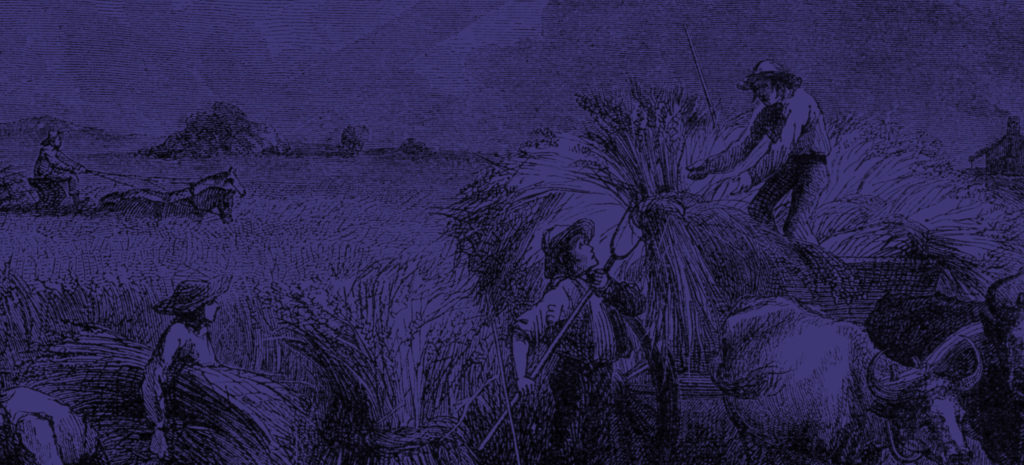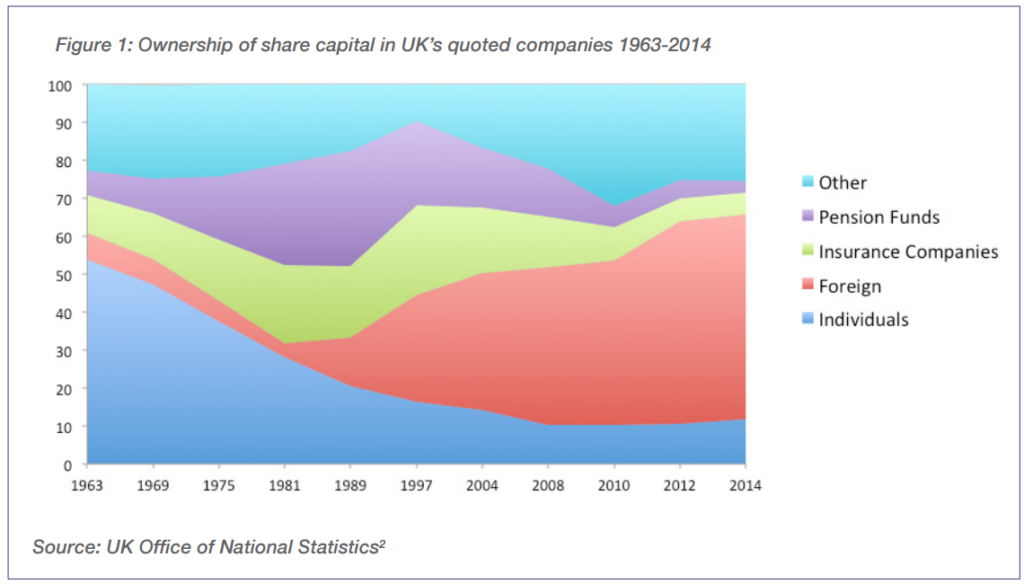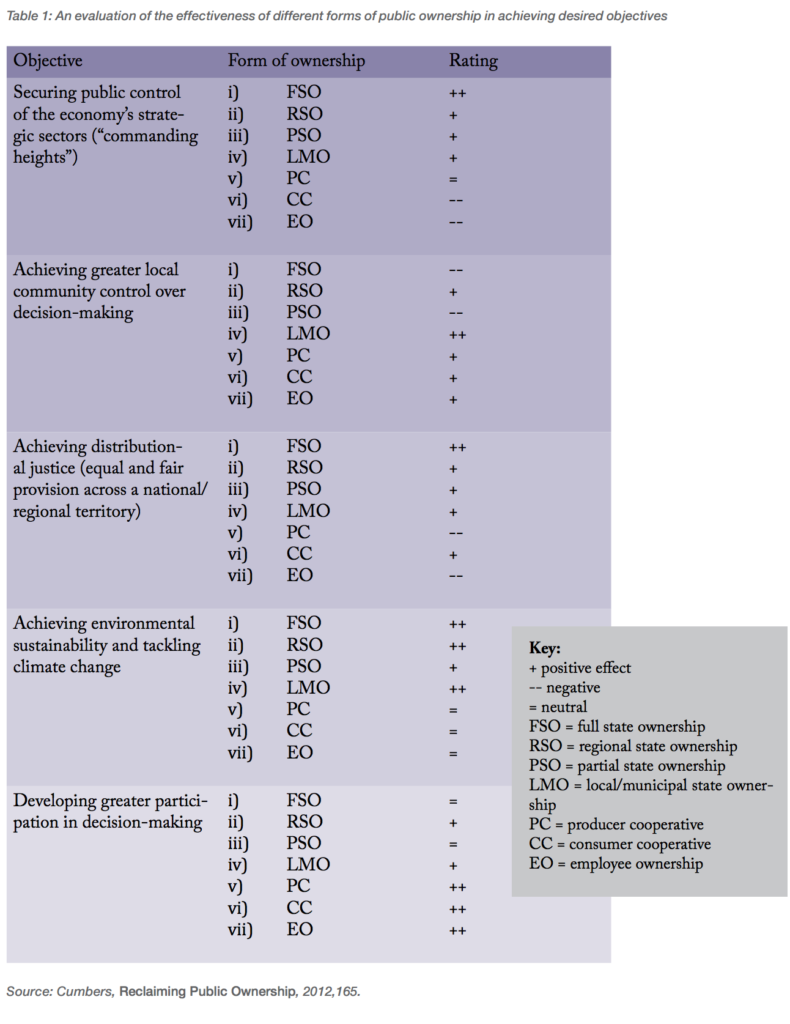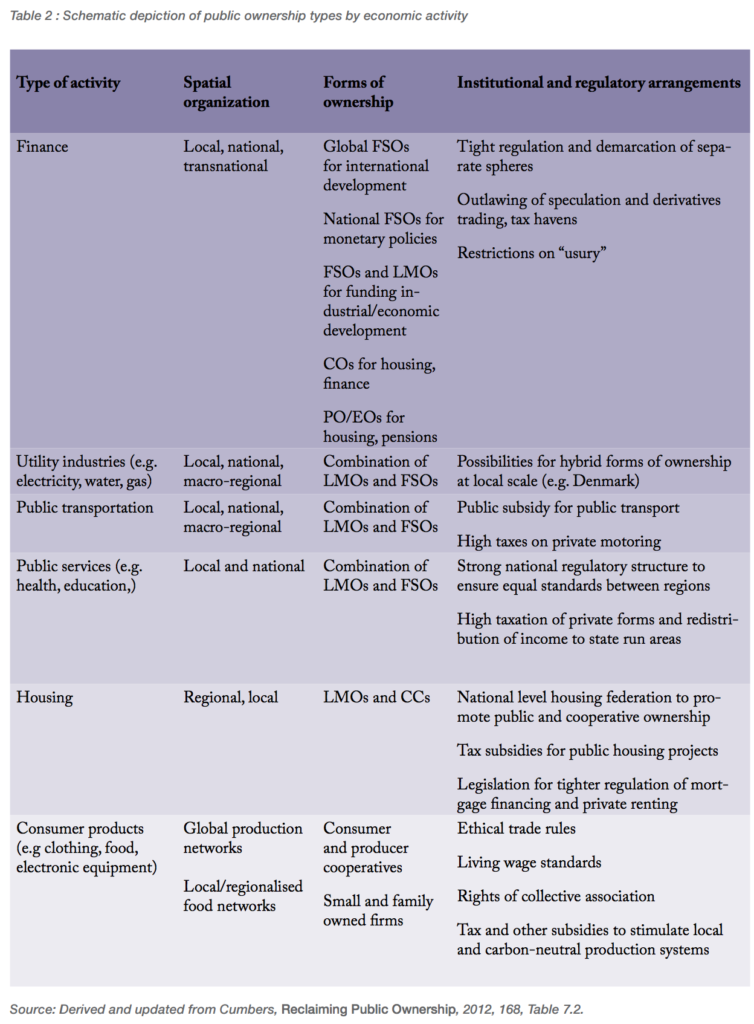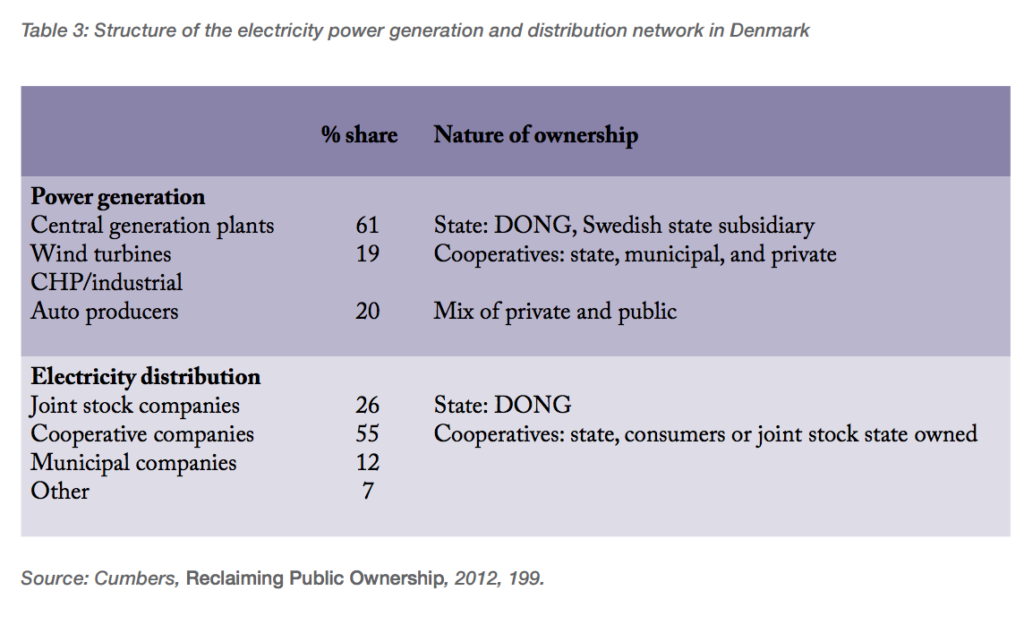Diversifying Public Ownership
PARADIGM CHANGES, 1 May 2017
Andrew Cumbers | The Next System Project – TRANSCEND Media Service
18 Apr 2017 – This paper is one of many proposals for a systemic alternative we have published or will be publishing here at the Next System Project. We have commissioned these papers in order to facilitate an informed and comprehensive discussion of “new systems,” and as part of this effort, we have also created a comparative framework which provides a basis for evaluating system proposals according to a common set of criteria.
Core Goals
This paper advocates a form of economic democracy based around diverse forms of public ownership. It does not prioritize one particular scale but recognizes the importance of decentralized forms of public ownership, to encourage greater public participation and engagement, mixed with higher level state ownership, for strategic sectors and planning for key public policy goals (e.g. tackling climate change). It takes a deliberately pluralistic definition of public ownership, recognizing both state ownership and the role that cooperatives and employee ownership could play in a more democratic economy. The main aim of the proposal outlined here is to enhance democratic participation and collective knowledge formation in relation to the economy. The paper outlined is premised on the principal that increased privatization of the economy is leading to growing inequalities, inappropriate policy formation, and decision-making in the interest of wealthy elites at the expense of a broader common good. In contrast, there is considerable evidence that greater collective ownership of the economy will lead to more progressive, egalitarian, and socially just outcomes that also offer more effective solutions to critical public policy problems, such as dealing with the effects of climate change.1
Major Changes
The modern contemporary economy is increasingly owned and controlled by a wealthy elite. Since the mid 1980s, a global privatization agenda has entrenched power by concentrating ownership even further. Although this is a global phenomenon, including in the US, the best exemplar of this trend is the UK, where the privatization programs pursued by Conservative governments diminished individual shareholding and increased corporate and foreign ownership of the economy (see Figure 1). Ironically, much of this is accounted for by foreign state owned, or partially stated-owned, corporations (e.g. French energy corporation EDF, or the German firm RWE) behaving much like private multinationals.
Different forms of public ownership are advocated for different parts of the economy, but with an emphasis upon the implementation of democratic and decentered institutional frameworks.
More recently, the growing influence of financial interests in economic ownership, notably hedge funds, private equity, and other investment vehicles, has further entrenched short-term rent seeking on behalf of vested interests over longer-term decision making on behalf of the common good. In opposition to these trends, the proposed model here involves developing alternative and more democratic models of economic organization and, in particular, constructing new and diverse forms of public ownership, defined in a broad sense (explained in more detail below). The model involves a mixed economy of varied forms of public ownership, in both planned and regulated market sectors, alongside small privately owned firms. Different forms of public ownership are advocated for different parts of the economy, but with an emphasis upon the implementation of democratic and decentered institutional frameworks. The idea of a “decentered” political economy here is critical and should not be confused with decentralization per se. Decentering can be defined as developing a political economy in which decision-making powers and knowledge formation are dispersed both functionally and geographically among different actors, rather than concentrated within particular groups. Both older forms of socialist central planning and the modern capitalist economy create agglomerations of power within elite groups, under both public and private ownership. An economy organized around public ownership should therefore be one that also disperses administrative units, knowledge production, and competence and has a plurality and diversity of organizations (e.g. mutual bodies, trade union research networks, small business associations, government, and autonomously funded think tanks) to offer alternative and competing interpretations of economic problems. Of course, there are no guarantees in any economic system that elite or special interests cannot capture policy agendas to the detriment of the common good, but dispersing functions, knowledge, and institutional capacity does at least provide important countervailing tendencies.
Principal Means
By public ownership here, I take a deliberately broad definition and prefer the term to that of commons or common ownership. The use of the term “public” is advocated in opposition to “private” in relation to economic ownership and the social relations that underpin the economy. The point here is that the pursuit of public ownership, in its strongest sense, implies an economy which is primarily owned collectively and, more importantly, subject to collective forms of decision making in opposition to corporate or financialized forms of ownership, which, under capitalism, involve the appropriation of both resources and labor for particular interests. Key to what follows here is that “public” includes both state forms of collective ownership but also non-state forms such as cooperatives and worker-owned enterprises. While small private firms are important in driving innovation and entrepreneurship, which helps to ensure dynamism (a key component in an evolving democratic economy), an agreed size threshold could be used to introduce forms of collective public ownership beyond a certain point. This could, in turn, help to prevent labor appropriation, or the emergence of a class of corporate vested interests.
Principles underpinning public ownership model
There are four underpinning principles that should provide the foundation for a publicly owned democratic economy.2 The first is that economic decision making should be dispersed and decentralized as democratically as possible across society, rather than concentrated and centralized in an elite group, whether that is a corporate and financial oligarchy or a board of directors running state enterprises at arm’s length from democratic control (i.e. what became known as the Morrisonian model of British nationalisation post 1945). Second, is a requirement for tolerance, respect, and engagement with different traditions of collective and public ownership. Third is the need for institutional economic forms that promote knowledge, innovation, and deliberation in economic practice. And finally, fourth is the integration of the second and third principles into a requirement for diversity and pluralism in organizational forms.
Delivering on these principles in the context of the current global economy, public ownership should have the following aspirations:
- To promote greater participation by workers, consumers, and citizens in general economic decision making.
- To regain the commanding heights of the economy (i.e. take into public ownership industries too strategically important to be left in private hands, such as banking, energy, and other utilities).
- To facilitate greater local community control over resources, especially in the context of increasingly destructive forms of ownership, such as private equity firms and other asset-stripping forms of private ownership.
- To redistribute income and wealth through cross-subsidization between sectors and social groups.
- To secure key environmental and social goals such as combating climate change and addressing growing inequalities.
Forms of ownership
Table 1 provides details of seven broad types of public ownership that are already present in the contemporary economy: full (national) state ownership (FSO), partial state ownership (PSO), regional or subnational state ownership (RSO) (e.g. Scotland, Catalonia, California, Alberta), local or municipal ownership (LMO), employee-owned firms (EO), producer cooperatives (PO), and consumer cooperatives (CO). In practice, there is also a range of hybrids that can be adopted as well as more loosely networked forms of organization that link different localities and communities to provide broader support and resources. There are interesting examples from Latin America of partnership between trade unions, municipal governments, and consumer groups in some remunicipalized public utility sectors such as water (see below). The table also provides an assessment of the role of the different forms of public ownership in promoting democratic engagement and fulfilling key public policy goals.
The table above is based upon my own assessment of the different forms of public ownership from particular country case studies developed at greater length in my book. Historical experience tells us much about the effects of different forms of public ownership. Full public ownership of entire sectors at higher scales (at national or regional levels under FSO or RSO), as occurred in many capitalist and also communist countries between 1945 and 1979, can deliver effective public control to achieve long-term strategic investment and key policy outcomes as evidenced by a variety of countries, from France to South Korea.3 More decentralized forms of public ownership, such as LMOs and the different types of cooperative identified here, are evident in Germany and Denmark, in the successful shift towards renewable energy where local community action and public participation have been important factors in generating progressive change. An important point to make is that there is a wide range of different models of public ownership that can deliver important public policy objectives while still being democratically accountable. There is also a trade-off between delivering very democratic and participatory economic institutions at the local community level (e.g. LMOs, PCs, EOs) and having higher national or even international level institutions (FSO, PSOs) that can undertake strategic initiatives to deal with broader issues of tackling equality and injustice. Regional state ownership models (RSOs) at the sub-national regional level (e.g. Hydro-Quebec, Scottish Water) might combine the best of both worlds—with capacity for higher geographical strategic coordination and closer social proximity to citizens than national level organizations.
Overall, we should aspire towards democratically controlled public ownership that are necessary at higher levels, whilst relinquishing control of other activities, as much as possible, to the local level. However, whatever form of ownership is chosen—and it should be recognized that in practice there are many different combinations—the aspiration should be towards democratic decision making, in which employees, consumers, user groups, and local communities have a voice. Taking an industry into full state ownership (FSO) will, in theory, secure the objectives of influencing key sectors and undertaking longer term strategic planning to secure important goals, such as dealing with climate change, and building and maintaining modern electricity or transport systems. Partial state ownership (PSO) is perhaps the most common form of state ownership in the contemporary economy, largely resulting from partial privatization processes, and is a feature in many European countries. FSOs and PSOs are also less likely to secure greater participation on the part of the ordinary citizen and there is a danger that, over time, they would become captured by elite groups and be subject to the kinds of principal agent problems that have occurred with earlier nationalizations. In the UK, for example, the state-owned electricity generation sector in the 1950s embarked upon a hugely costly program of nuclear power station construction with minimal public engagement where energy generation was made subservient to military objectives.4 On the other hand, it has been argued that more managerial autonomy is important to increase the efficiency of state-owned entities. In practice, these kinds of issues can never be fully eradicated, but the problems can be minimized where management and the workforce are given operational freedom whilst still being more broadly democratically accountable to clearly specified public goals.
The aspiration should be towards democratic decision making, in which employees, consumers, user groups, and local communities have a voice.
The Norwegian state oil company Statoil was a good example in the 1970s of an FSO given day-to-day managerial autonomy but whose remit was framed within a broader context of pursuing progressive social and environmental policies. 5 While local municipal ownership models (LMOs) are spatially closer to local communities and citizens, they also run the risk of capture by elite groups, particularly at the level of city governance for the development of boosterish projects (e.g. gentrification, event-led regeneration, such as Olympic Games hosting) that may benefit particular groups over the more general interest. Cooperative and employee-owned firms (EO, PO, CO) clearly score highest in terms of democratic participation and involvement but arguably will do less well at securing broader policy objectives. While an economy completely composed of decentralized cooperative firms will more than likely shift the overall nature of economic values towards more socially progressive ends, without countervailing forms of ownership, it could also create new hierarchies if some groups (e.g. employees, producer interests) begin to monopolize decision making at the expense of others (e.g. pensioners, the unemployed).
Hybrid public ownership
Recent years have seen considerable experimentation with new forms of public ownership with a pronounced trend towards more hybrid forms of ownership that combine state and non-state forms of collective ownership. Examples of this abound in Latin America, where resistance to privatization, and remunicipalization following successful campaigns, has resulted in the establishment of new public organizations that seem to broaden participation and democracy. A good example was the setting up of a new public corporation, Aguas Argentinas SA in the Greater Buenos Aires region of Argentina. Aguas Argentinas was founded as a response to the failed privatization by a US-led consortium of multinational corporations. And, as such, was a specially created cooperative with shares held jointly by the local authority and the water and sanitation workers trade union. Another example, from the energy sector, is the Mittlegrunden wind farm, constructed off the coast of Copenhagen in 2001 and providing 3 percent of the Danish capital’s electricity needs. Ownership of the wind farm was originally divided fifty-fifty between the city’s own municipal energy company and a specially created cooperative, although recently DONG bought the city council’s stake. As a result, there are 8,700 residents with shares in the project, administered through the bespoke cooperative.
Geographic Scope
Globalization over the period since 1980 has in many ways undermined the sovereignty of national states to effectively manage the economy. The growth of multinational corporations, the increased complexity of commodity chains, and the deregulation (mostly by central state governments themselves) of financial markets have all made it more difficult to construct effective organizational models and systems oriented towards the national scale. However, as the recent financial crisis and subsequent wave of bank nationalizations demonstrated, national states remain the only political actors capable of using their legislative and regulatory powers to enact broader systemic change when economic crises occur. Only within the European Union, inside the Eurozone, have national governments effectively ceded power completely to higher-level supra-state disciplining mechanisms. Though even in these cases, it is dominant national states, notably Germany, that control macroeconomic decision making.
There is no one size fits all institutional design but instead a diverse set of spatial configurations that reflect both social needs and the technical requirements of the economy across different sectors.
With these kinds of caveats in mind, the model proposed here takes the national state economic space as the critical container for alternative forms of public ownership, but is alert to the multi-scalar realities of the contemporary economy. Thus, there is no one size fits all institutional design but instead a diverse set of spatial configurations that reflect both social needs and the technical requirements of the economy across different sectors. Strategies for democratic public ownership will also need to be sensitive to geographical and historical contingency and work with the grain of existing public ownership practice. More decentralized forms of public ownership, organized around cooperatives and local state ownership might work better in federal systems with strong traditions of local mutualism, in countries such as Germany and the United States, than in more centralized economic systems such as the UK, where older forms of public ownership have been highly centralized. But again, this will vary by sector. While democracy is best served by attempting to disperse rather than centralize economic decision-making power, and in many cases through spatial decentralization, the realities of globalization and the complexities of advanced economies mean that there is often, in practice, a trade off between higher-level coordination and local autonomy and participation. This can, of course, be overcome through confederal structures; for example, national publicly owned rail networks might have democratic boards composed of locally and regionally elected consumer representatives.
There is also the thorny issue of the balance between encouraging local autonomy in terms of ownership versus making a commitment to equity and distributional justice. Where it is economically efficient to organize decision making on more localized lines, it would still be necessary to require some forms of centralized coordination and regulation to safeguard the basic economic, social, and cultural rights of each citizen. The US history of racial segregation and discrimination at the local and state level reminds us of the need for clearly defined national (and even international) basic economic and social rights. The latter would infer higher-level state regulation, particularly in sectors that have a direct bearing on human well-being and flourishing, such as health, housing, and energy. Where local public ownership is adopted this would need to be set within frameworks of universal constitutional rights to basic provision at affordable cost across national state jurisdictions. Moreover, even if we accept the basic principles of decentered decision making, there will still need to be some democratically elected way of dealing with the broader macroeconomic decisions at higher scales—at the national, supranational (e.g. EU), and even global level; for example, in the case of a tax on financial speculation.
Table 2 provides an illustrative sketch of how these different forms of public ownership might be applied in practice across the range of economic sectors. The list is far from exhaustive, but shows how a very different kind of economy might be built around collective forms of ownership and institutions intended to benefit the community or “general interest,” rather than being dominated by and exploited on behalf of elite groups. Profiteering and speculation in the financial sector have created massive inequities between different social groups over the past three decades without adding to the general common wealth. As is now well recognized, the private and deregulated model precipitated the financial crisis and subsequent recession in the years after 2008. In its place we could develop a very different publicly owned sector.
A mix of ownership forms would be consonant with the different needs and uses of money and credit. State ownership, at a range of scales, could be used to secure broader macroeconomic objectives, relating to stabilizing the economy. This could be done in the manner currently undertaken by central banks, but requiring the re-democratization of these institutions away from the “independent” control of financial and economic elites. Thus putting social goals (job creation and reducing unemployment) ahead of austerity and monetary policy driven by inflation. Below the national or federal level, regional state reserve banks (the model of Germany’s Landesbanken is relevant here) could be tasked with securing sustainable and balanced local and regional economic development. In the US context, this might mean more autonomy for existing regional Federal Reserve banks. We should push for much greater political interference in central bank decision making, but this should be of the deliberative kind that involves institutions and opens them up to broader scrutiny. Technical committees and managerial appointees could still be drawn from the economics profession (broadly conceived, rather than reduced to the paradigm of mainstream neoclassical economics), but legislators should set strategic priorities. National and regional development banks, also under state ownership, could be tasked with investing in key sectors and initiatives, and promoting training, research and development, for example, in renewable energy or medical research.
We should push for much greater political interference in central bank decision making, but this should be of the deliberative kind that involves institutions and opens them up to broader scrutiny.
Such banks should not be beholden to, or seen as compatible with, private, commercially driven banks, as seems to be the case with many existing state banks across the globe. Instead, they should be driven by a broader public interest requirement, and tasked to meet particular social and environmental goals, rather than operating on narrow (short term), profit-making criteria. This could include supporting local community development banks and credit unions, or democratized banks. The utilities are another example of a set of strategic activities that require management by and for the community as a whole. Many are, of course, natural monopolies—such as public transport, electricity, and water supplies—and also require higher levels of coordination to deliver economies of scale. But these can, in some instances, be combined with more local and decentralized forms. Water supplies, for example, can be organized effectively at the municipal or regional scales, as is the case in many European countries. Power generation needs national and even supranational coordination of grid networks to deliver key public policy goals such as tackling climate change and eradicating fuel poverty. Once again, this could be achieved through confederal structures, with national entities constituted by democratically elected representatives of local and regional public companies (see the Danish case below). However, more localized forms of ownership could be developed for particular aspects of the sector, notably community ownership of renewables schemes.
Public transportation and public services such as health and education should be broadly organized in the public sector, but these could take a range of different forms, from local community cooperatives to more national forms (such as educational authorities and basic healthcare) where the demands of distributive justice, efficiency, and cross-subsidization of poorer groups warrant higher scales of organization. These are sectors where private ownership and market-based forms of delivery should be kept to a minimum, or even outlawed because of the importance of care and nurturing in sectors where social rights should take precedence over monetary valuation and commodification. The US health care system provides the test case example of how not to do things in this respect. Not only do its market-based values infringe on human dignity and the right to decent care, but it is also very inefficient, with price fixing and significant public investment serving to hide market failure, ultimately leading to poor outcomes.
Housing is a sector where a more diverse mix of ownership forms would be preferable. Private housing should be allowed but legislation and regulation (e.g. community land trusts, land value taxes) could be used to challenge its hegemonic and privileged status and free the sector from speculative and financialized interests. A more regulated system, allowing private ownership but reducing speculation, would keep assets at affordable levels for communities and actually promote the rights of all individuals and families to decent housing, whether in the public or private system. This would provide real consumer choice, rather than the faux choice of speculator driven subprime markets.
Social housing needs to be a lifestyle choice possibility rather than the stigma of a residualized underclass.
An important element of this would be to channel more finance and investment towards a variety of forms of collective ownership. While cooperative forms could be encouraged, more democratic forms of state ownership as an alternative to mortgage thralldom should be an aspiration of progressive housing governance. Social housing needs to be a lifestyle choice possibility rather than the stigma of a residualized underclass. This is also a sector where hybrid forms of public ownership, part local state and part cooperative ownership, could play an important part. Similar arguments can be made about the need for more public regulation and control of land, although there is not the space here to do justice to what is a massive area of controversy and public concern.
More diverse forms of collective ownership could also be given greater encouragement in consumer goods sectors, where competitive markets perform the most important function in providing market signals and stimulating innovation. There are plenty of examples of retail chains in Western Europe and Scandinavia that are already cooperatively or employee owned and which provide a high level of service and quality of product (the John Lewis chain in the UK being a prominent example). These could, however, be subject to a stricter set of ethical rules around employment conditions, fair trade, and environmental best practice.
Temporal Scope
Two real world examples typify the spirit of the approach suggested here: Norway’s model of oil development and the Danish experiences of renewable energy.6 Both are good examples of public ownership regimes, which, in different contexts and taking different forms, have strong elements of economic democracy and public participation built into them. They highlight in particular the extent to which very different geographical and institutional configurations can provide more participatory forms of economic governance that challenge elite capture. While they both emanate from the energy sector, the key themes underpinning them, regarding the mix between state regulation and legislation to foster both democratic public ownership but also public participation and collective learning processes, are replicable. Hence, encasing public ownership within an active civil society is replicable elsewhere.
Norway’s oil experience: state ownership, active civil society, and deliberative democracy
The “Norwegian model” is rightly acclaimed around the world for its approach to North Sea oil and gas development, particularly for dispersing the benefits throughout the country’s economy and society, rather than allowing resources to be captured for vested interests. After almost forty years of oil development, Norway remains one of the most egalitarian societies on the planet, and compares particularly favorably with the UK. It consistently ranks at the top of the United Nations Human Development Index (number one for the most recent rankings in 2014).7 Norway’s careful husbandry of its oil interests has been a critical part of this story. Its experience is particularly interesting for us here because of the nature of state intervention and public ownership in the development of its oil and gas resources.
When the first discoveries were made in the 1960s, the approach adopted had much in common with Third World countries in dealing with the power of the international oil cartel: a nationalized entity was set up using a “top-down” model of state ownership, which was led initially by elite groups within the central state apparatus.
The transition to a democratic, publicly owned economy envisaged here would take considerable political mobilization.
However, over time, as the magnitude of oil resources became apparent, a much more wide-ranging debate over the impact of oil on Norwegian society and culture developed that went beyond narrow economic considerations. In the process, some critical institutions and mechanisms emerged that have embedded oil development within a more deliberative and democratic framework, where more progressive agendas have developed with regard to the environment, social development, and workplace health and safety (see below). Critical to the creation of this approach was an active civil society and a long tradition of viewing natural resource extraction in terms of broader community and social benefits. This political and cultural context has inscribed an important set of ethical and institutional norms regarding the relationship between natural resources and economic interests.
Influenced by the American progressive journalist Henry George, the Norwegian justice minister, Johan Carlsberg, believed firmly that the economic rent emanating from natural resources should not be captured by any private individual or group of private interests but should be the “common property of the people.” 8 Norwegian oil policy also subsequently created a number of other important mechanisms and institutions to secure the national collective interest and ensure that society as a whole both benefited from oil and gas but also shared in the public debate during the 1970s about the future direction of the nation’s resources.
These included the creation of the state’s direct financial interest (SDFI) in oil development in 1985. The latter was established because of fears that Statoil was becoming too powerful and is now managed by a state-owned company, These included the creation of the state’s direct financial interest (SDFI) in oil development in 1985. The latter was established because of fears that Statoil was becoming too powerful and is now managed by a state-owned company, Petero. A separate state oil fund—known as the “Government Pension Fund Global”— was established in 1990, which is currently worth around £600 billion.9 The fund has recently been subject to much tougher ethical investment rules including divestment from coal-fired energy, allowing it to play a progressive outward facing role as one of the largest global investment funds. Two other important institutions were critical in the creation of a more progressive and democratic Norwegian approach to managing oil resources. The first was the creation of a Petroleum Directorate as a separate organizational actor from Statoil. Petroleum Directorate was charged with administering, regulating, and controlling oil and gas resources independent of the oil companies.
While Statoil was always meant to be a commercial operation at arm’s length from government, the company had to present an annual report to parliament on “significant issues relating to principles and policy.”
One of the consequences of this was the development of the safest offshore oil and gas regime in the world from the early 1980s onwards. But the Directorate also developed its own professional and technical expertise in all matters to do with oil. The second feature was the establishment of what became known as the Paragraph 10 clause in the legislation that created Statoil. While Statoil was always meant to be a commercial operation at arm’s length from government, the clause outlined that the company had to present an annual report to parliament on “significant issues relating to principles and policy.”10 The effect was that the company, and more broadly, the impact of oil on Norway, was the subject of continuing scrutiny and debate into the 1990s.
A whole series of committees in the Storting (Norwegian Parliament) set up their own consultation exercises, including Social Affairs, Foreign Affairs, and Local Government, to consider all aspects of oil development, in the process drawing upon a diverse range of knowledge and expertise from all sectors of civil society, including professional associations, trade unions, fishing and farming interests, church groups, and trade unions. Overall, there was an impressive process of wide-ranging deliberation on questions of oil policy, as well as collective learning, so that many parliamentarians also developed extensive knowledge of oil affairs. The outcome was probably the most progressive approach to energy development ever seen, which involved the following radical proposals: Norway committed itself to a “socialised” model of oil, key elements of which were the priority that oil should create a “qualitatively better society” and, crucially, a “moderate rate of oil extraction,” with a 90 million tonne ceiling that was not breached until the early 1990s.11 Additionally, emphasis was put on developing the resource in the most environmentally friendly manner, as well as using revenues from oil extraction to boost the country’s spending on international development.
Denmark’s wind power revolution: a lesson in diversified and decentered public ownership
Where Norway’s example shows how an older form of top-down public ownership—a state enterprise—can be embedded in democratic and participatory frameworks of governance, the Danish experience with renewable energy points us in the direction of a diversified and innovative mix of forms of public or common ownership that might enrich democratic processes in the economy. In the field of energy policy, Denmark has been held up as a model by the International Energy Agency for its far-sighted approach to tackling climate change.
The country went from being completely dependent on foreign oil and gas for its energy needs in the 1970s, to a situation where renewable energy now accounts for over 20 percent of primary energy production.12 The cornerstone of this success was the emergence of a wind power industry, which has not only been at the forefront of Denmark’s strategy to increase self-reliance and reduce CO2 emissions but has also created 20,000 jobs and has given the country’s firms 50 percent of the world market for wind turbine manufacturing.13
The Danish experience with renewable energy points us in the direction of a diversified and innovative mix of forms of public or common ownership.
This success has been based upon public ownership and planned interventions, but is neither a top-down, state-driven process, nor a grassroots achievement. Instead, it reflects the combination of state action, grassroots social mobilization, and a diversified set of public ownership arrangements operating at different geographical scales. While it reflects some important historical and geographically specific factors, it also offers some important insights for developing more sustainable and democratically based forms of economy.
The oil crises of the 1970s exposed Denmark’s vulnerability to imported oil, accounting for around 90 percent of the country’s energy demand by 1973.14 Rising oil prices over the course of the decade prompted a rethink of Danish energy policy. While the country lacked the vast oil and gas resources of the UK and Norway, there were still important discoveries in the Danish North Sea that enabled the country to reduce its dependence on imports during the 1980s. However, Denmark still faced significant problems and some hard choices in
achieving long-term security of energy supply.
In this context, there was an intense political struggle over the direction of energy policy. Much of the country’s political and business establishment favored nuclear power as an alternative to oil, but was opposed by a coalition of green, left, and rural communities around an alternative vision of a more localized, decentered model based on renewable energy. An important factor that probably helped to tip the balance away from nuclear was the continuing tradition of interest in wind power as an alternative. Moreover, the existence of engineering and scientific communities that were able to showcase the viability of non-nuclear technologies in a populist way helped to foster an alternative discourse around “clean” and “pure” energy. By 1980, the Danish government had embarked upon a decisive strategy in support of renewables with a model of decentered and localized forms of collective ownership to the fore. There were three critical pillars of government policy:
- First, government funding for 30 percent of all investment in new wind turbines over the period from 1980 to 1990 gave an important boost to Danish wind power producers.
- Second, the “Energipakken,” was introduced which compelled electricity distribution companies to purchase a certain quota of energy supply every year from renewable producers as part of nationally set targets.
- Third, and most pertinent to our interests here, the encouragement of local and collective ownership of turbines occurred largely through a series of laws that limit ownership of wind turbines to those residing in the municipality where the turbine is built, known as “residency criteria,” or distance regulation laws.
Together, these policies gave a massive boost to the wind power industry with a particularly pronounced period of growth in the second half of the 1990s (see Figure 2) following the establishment of the feed-in-tariff, a policy that has subsequently been applied in other EU countries.
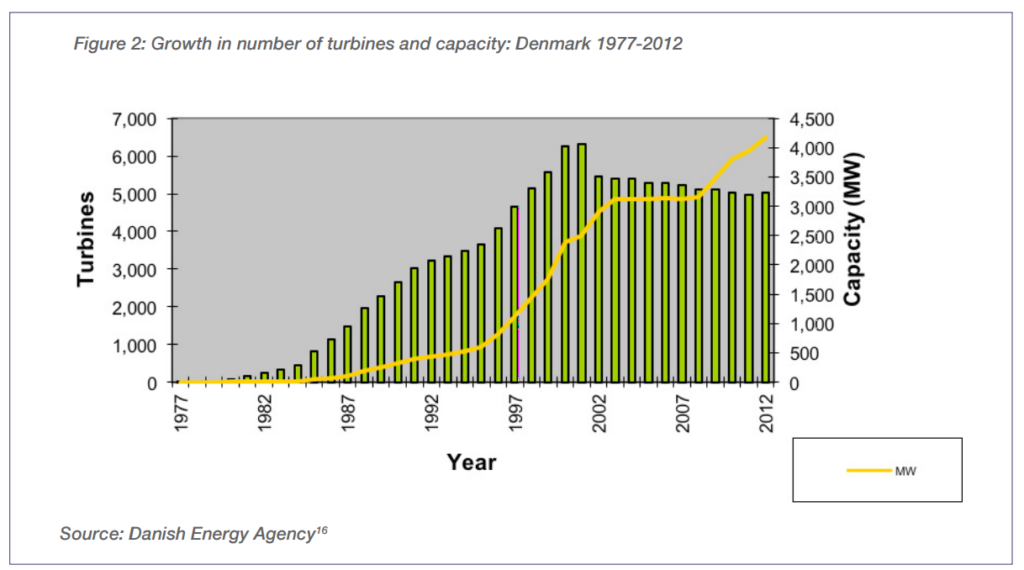
Although its local ownership laws have been relaxed more recently with the election of more center right governments, they gave critical political momentum to localized and collective forms of ownership, which have had long-lasting effects. They have meant that wind turbine ownership remains dominated by either small-scale forms of private ownership (typically partnerships between local neighbours) or cooperative forms. The first Danish onshore “wind farms,” which covered extensive areas and supplied energy to more than a local neighbourhood, were all cooperatively owned. At the height of local ownership of turbines in the late 1990s, it was estimated that 150,000 families or around 10 percent of the population were involved.15 The participation of communities in the ownership and development of the technology has been a critical factor in the successful growth of renewable energy capacity. Surveys suggest around 70 percent of the population are in favor of wind farms, with only around 5 percent against them; these figures are far higher than found elsewhere.16
The participation of communities in the ownership and development of the technology has been a critical factor in the successful growth of renewable energy capacity.
Together, the “distance regulation” laws, state support for renewables, and the localist and collectivist traditions of Danish society have been important in both dispersing economic power and creating the conditions for greater public participation, deliberation, and economic democracy in the energy sector. At this point, it is also worth emphasising the decentralized and cooperative nature of the electricity distribution system, in contrast with the more centralized systems put in place through nationalization in France and the UK after 1945. Therefore, the model here may not be easily transplantable to more centralized energy systems where national grids rely on older generations of coal, gas, and nuclear power stations. However, the dispersed nature of low carbon energy technologies may provide momentum for more localized forms of organization and ownership to develop in any case.
Today, Denmark’s broader electricity system remains heavily decentralized with around one hundred local distribution companies (primarily cooperatively and municipally owned) and ten regional transmission networks (which are amalgamations of the one hundred local cooperatives).17 This means that local cooperative and mutual forms of ownership dominate the electricity distribution system (see Table 3). While there is still a more traditional oil and coal-fired centralized power generation system around the state-owned energy company, DONG (Dansk Olie og Naturgas A/S), and Vattenfall, a subsidiary of the Swedish state-owned corporation, turbine growth has helped to provide a strong element of localization in power generation.
Boards of municipal companies (which tend to be in the main urban centers) are appointed by the local government, whereas the cooperatives (which tend to be rural) are democratically elected at meetings of consumers. Representatives from the local boards, in turn, elect the regional companies. Overall, the Danish energy network is remarkable for its level of public participation and democratic decision making, and for the manner in which these powers are “decentered” and not bound up in one organization or set of elite institutions. The network has also created an active and knowledgeable civil society around renewable energy and climate change politics, which represents a progressive force for broader processes of social and environmental change.
Interestingly, there have been some innovative hybrid forms of local public ownership since 2000, notably the development of partnerships between municipal and publicly owned utility companies or by partnerships between the municipal governments and residents’ cooperatives. Perhaps the best example is the Mittlegrunden wind farm, referred to earlier. But hybrid models are also being encouraged in offshore wind projects where new ventures must offer a 20 percent stake to bespoke local residents’ cooperatives.18
Conclusion
The model of economic democracy here envisages a mixed economy populated by a diversity of forms of public ownership. The model is in opposition to the increasingly corporatized and financialized system that currently exists. A key principle articulated here is that of “decentering” the economy by encouraging a diffusion of economic decision making across the economy and a variety of different democratic forms of ownership, ranging from national state to local cooperatives and employee-owned firms. Seven possible forms of public ownership are identified, although these are not exclusive and could be combined in forms of hybrid public ownership in order to further widen democracy through structures that encourage multiple stakeholders and interest groups to be involved in economic decision making. There is no one model of public ownership applicable in all contexts, but distinctive forms will be appropriate in different economic sectors. The paper provides a schematic overview of how this could look in practice across the main sectors of an economy.
ENDNOTES:
| 1. | ↑ | For greater elaboration of these issues, see Andrew Cumbers, Reclaiming Public Ownership (London: Zed Books, 2012). |
| 2. | ↑ | Cumbers, Reclaiming Public Ownership, 145 – 146. |
| 3. | ↑ | Cumbers, Reclaiming Public Ownership. |
| 4. | ↑ | Cumbers, Reclaiming Public Ownership, 21. |
| 5. | ↑ | Cumbers, Reclaiming Public Ownership, Chapter 8. |
| 6. | ↑ | Descriptions of the models outlined here can be found in greater depth in Cumbers, Reclaiming Public Ownership. |
| 7. | ↑ | United Nations Development Programme, “Human Development Reports,” United Nations, 2014, http://hdr.undp.org/en/composite/HDI. |
| 8. | ↑ | Helge Ryggvik, The Norwegian Oil Experience: a Toolbox for Managing Resources (Oslo, Norway: University of Oslo, Centre for Technology, Innovation and Culture, 2010), http://www.sv.uio.no/tik/forskning/publikasjoner/tik-rapportserie/Ryggvik.pdf |
| 9. | ↑ | “IQ 2016 Quarterly Report,” Norges Bank, https://www.nbim.no/en/transparency/reports/2016/1q-2016-quarterly-report/. |
| 10. | ↑ | Ryggvik, The Norwegian Oil Experience, 100. |
| 11. | ↑ | Ryggvik, The Norwegian Oil Experience, 34-35. |
| 12. | ↑ | Danish Energy Agency (DEA), “2015 Key Figures from DEA’s Preliminary Energy Statistics Danish Energy Agency,” accessed August 2016, http://www.ens.dk/en/info/news-danish-energy-agency/2015-denmark-hits-lowest-energy-consumption-more-40-years. |
| 13. | ↑ | Danish Energy Agency (DEA), Danish Energy Policy 1970-2010 (DEA: Copenhagen, Denmark, 2010). |
| 14. | ↑ | Cumbers, Reclaiming Public Ownership, 193. |
| 15. | ↑ | Cumbers, Reclaiming Public Ownership, 197 |
| 16. | ↑ | Hans Christian Soerensen, Lars Kjeld Hansen, Karin Hammarlund, and Jens Larsen, Experience with and Strategies for Public Involvement in Offshore Wind Projects (Brussels: Institute for Infrastructure, Environment and Innovation, 2003). |
| 17. | ↑ | Cumbers, Reclaiming Public Ownership, 198. |
| 18. | ↑ | Danish Government, Promotion of Renewable Energy Act 2008, Section 13 (1), p. 5, accessed August 2016, http://www.ens.dk/sites/ens.dk/files/undergrund-forsyning/vedvarende-energi/vindkraft-vindmoeller/havvindmoeller/kystnaere/promotion_of_renewable_energy_act.1392.2008.pdf. |
____________________________________________
 Andrew Cumbers is professor of regional political economy at the University of Glasgow. He has written extensively on the problems and the prospects for a more democratic and egalitarian economy and society. He is currently working on a project funded by The Economic and Social Research Council to create an Economic Democracy Index. His book Reclaiming Public Ownership (Zed) won the 2015 Gunnar Myrdal Prize for Evolutionary Political Economy.
Andrew Cumbers is professor of regional political economy at the University of Glasgow. He has written extensively on the problems and the prospects for a more democratic and egalitarian economy and society. He is currently working on a project funded by The Economic and Social Research Council to create an Economic Democracy Index. His book Reclaiming Public Ownership (Zed) won the 2015 Gunnar Myrdal Prize for Evolutionary Political Economy.
Go to Original – thenextsystem.org
DISCLAIMER: The statements, views and opinions expressed in pieces republished here are solely those of the authors and do not necessarily represent those of TMS. In accordance with title 17 U.S.C. section 107, this material is distributed without profit to those who have expressed a prior interest in receiving the included information for research and educational purposes. TMS has no affiliation whatsoever with the originator of this article nor is TMS endorsed or sponsored by the originator. “GO TO ORIGINAL” links are provided as a convenience to our readers and allow for verification of authenticity. However, as originating pages are often updated by their originating host sites, the versions posted may not match the versions our readers view when clicking the “GO TO ORIGINAL” links. This site contains copyrighted material the use of which has not always been specifically authorized by the copyright owner. We are making such material available in our efforts to advance understanding of environmental, political, human rights, economic, democracy, scientific, and social justice issues, etc. We believe this constitutes a ‘fair use’ of any such copyrighted material as provided for in section 107 of the US Copyright Law. In accordance with Title 17 U.S.C. Section 107, the material on this site is distributed without profit to those who have expressed a prior interest in receiving the included information for research and educational purposes. For more information go to: http://www.law.cornell.edu/uscode/17/107.shtml. If you wish to use copyrighted material from this site for purposes of your own that go beyond ‘fair use’, you must obtain permission from the copyright owner.
